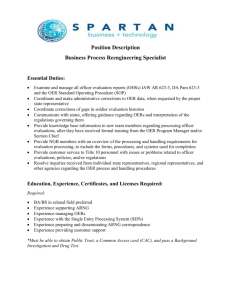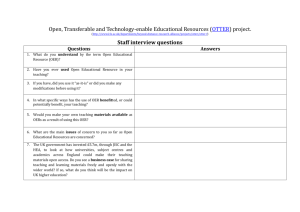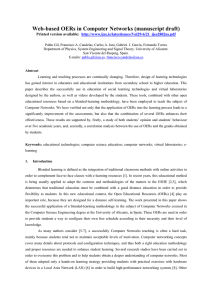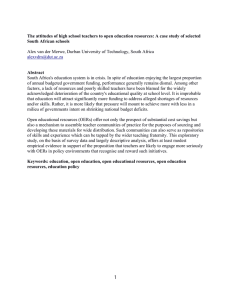Using pair work - The Open University
advertisement
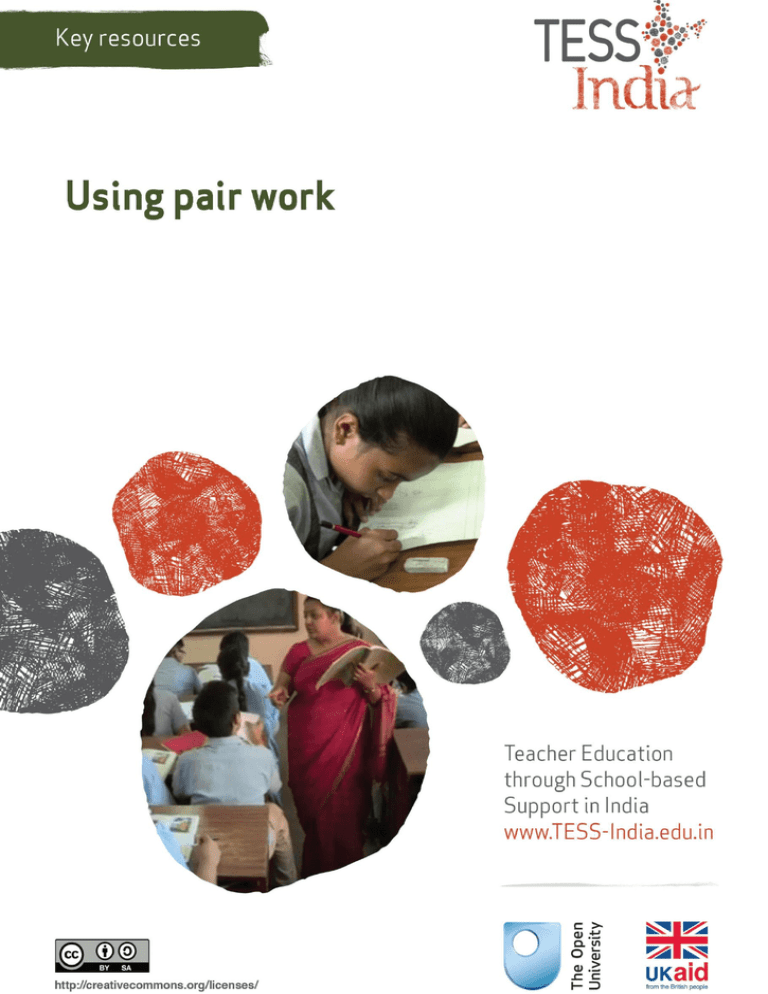
TESS-India (Teacher Education through School-based Support) aims to improve the classroom practices of elementary and secondary teachers in India through the provision of Open Educational Resources (OERs) to support teachers in developing student-centred, participatory approaches. The TESS-India OERs provide teachers with a companion to the school textbook. They offer activities for teachers to try out in their classrooms with their students, together with case studies showing how other teachers have taught the topic and linked resources to support teachers in developing their lesson plans and subject knowledge. The TESS- India OERs are supported by a set of ten key resources. These key resources, which apply to all subjects and levels, offer teachers further practical guidance on key practices in the pedagogy modelled in TESS-India OER and India policy. They include ways of organising students, learning activities and teacher– student and student–student interactions. Excerpts from these key resources will be inserted into the OERs. They will also be available on the website for teachers and teacher educators. TESS-India is led by The Open University UK and funded by the UK government. Version 2.0 KR04v1 Except for third party materials and otherwise stated, this content is made available under a Creative Commons Attribution-ShareAlike licence: http://creativecommons.org/licenses/by-sa/3.0/ Key resource: Using pair work Using pair work In everyday situations people work alongside, speak and listen to others, and see what they do and how they do it. This is how people learn. As we talk to others, we discover new ideas and information. In classrooms, if everything is centred on the teacher, then most students do not get enough time to try out or demonstrate their learning or to ask questions. Some students may only give short answers and some may say nothing at all. In large classes, the situation is even worse, with only a small proportion of students saying anything at all. Why use pair work? Pair work is a natural way for students to talk and learn more. It gives them the chance to think and try out ideas and new language. It can provide a comfortable way for students to work through new skills and concepts, and works well in large classes. Pair work is suitable for all ages and subjects. It is especially useful in multilingual, multi-grade classes, because pairs can be arranged to help each other. It works best when you plan specific tasks and establish routines to manage pairs to make sure that all of your students are included, learning and progressing. Once these routines are established, you will find that students quickly get used to working in pairs and enjoy learning this way. Tasks for pair work You can use a variety of pair work tasks depending on the intended outcome of the learning. The pair work task must be clear and appropriate so that working together helps learning more than working alone. By talking about their ideas, your students will automatically be thinking about and developing them further. Pair work tasks could include: ‘Think–pair–share’: Students think about a problem or issue themselves and then work in pairs to work out possible answers before sharing their answers with other students. This could be used for spelling, working through calculations, putting things in categories or in order, giving different viewpoints, pretending to be characters from a story, and so on. Sharing information: Half the class are given information on one aspect of a topic; the other half are given information on a different aspect of the topic. They then work in pairs to share their information in order to solve a problem or come to a decision. Practising skills such as listening: One student could read a story and the other ask questions; one student could read a passage in English, while the other tries to write it down; one student could describe a picture or diagram while the other student tries to draw it based on the description. Following instructions: One student could read instructions for the other student to complete a task. Storytelling or role play: Students could work in pairs to create a story or a piece of dialogue in a language that they are learning. www.TESS-India.edu.in 1 Key resource: Using pair work Managing pairs to include all Pair work is about involving all. Since students are different, pairs must be managed so that everyone knows what they have to do, what they are learning and what your expectations are. To establish pair work routines in your classroom, you should do the following: Manage the pairs that the students work in. Sometimes students will work in friendship pairs; sometimes they will not. Make sure they understand that you will decide the pairs to help them maximise their learning. To create more of a challenge, sometimes you could pair students of mixed ability and different languages together so that they can help each other; at other times you could pair students working at the same level. Keep records so that you know your students’ abilities and can pair them together accordingly. At the start, explain the benefits of pair work to the students, using examples from family and community contexts where people collaborate. Keep initial tasks brief and clear. Monitor the student pairs to make sure that they are working as you want. Give students roles or responsibilities in their pair, such as two characters from a story, or simple labels such as ‘1’ and ‘2’, or ‘As’ and ‘Bs’). Do this before they move to face each other so that they listen. Make sure that students can turn or move easily to sit to face each other. During pair work, tell students how much time they have for each task and give regular time checks. Praise pairs who help each other and stay on task. Give pairs time to settle and find their own solutions – it can be tempting to get involved too quickly before students have had time to think and show what they can do. Most students enjoy the atmosphere of everyone talking and working. As you move around the class observing and listening, make notes of who is comfortable together, be alert to anyone who is not included, and note any common errors, good ideas or summary points. At the end of the task you have a role in making connections between what the students have developed. You may select some pairs to show their work, or you may summarise this for them. Students like to feel a sense of achievement when working together. You don’t need to get every pair to report back – that would take too much time – but select students who you know from your observations will be able to make a positive contribution that will help others to learn. This might be an opportunity for students who are usually timid about contributing to build their confidence. If you have given students a problem to solve, you could give a model answer and then ask them to discuss in pairs how to improve their answer. This will help them to think about their own learning and to learn from their mistakes. If you are new to pair work, it is important to make notes on any changes you want to make to the task, timing or combinations of pairs. This is important because this is how you will learn and how you will improve your teaching. Organising successful pair work is linked to clear instructions and good time management, as well as succinct summarising – this all takes practice. 2 www.TESS-India.edu.in Key resource: Using pair work Acknowledgements This content is made available under a Creative Commons Attribution-ShareAlike licence (http://creativecommons.org/licenses/by-sa/3.0/), unless identified otherwise. The licence excludes the use of the TESS-India, OU and UKAID logos, which may only be used unadapted within the TESS-India project. Every effort has been made to contact copyright owners. If any have been inadvertently overlooked the publishers will be pleased to make the necessary arrangements at the first opportunity. Key resources include contributions from: Deborah Cooper, Beth Erling, Jo Mutlow, Clare Lee, Kris Stutchbury, Freda Wolfenden and Sandhya Paranjpe. www.TESS-India.edu.in 3
